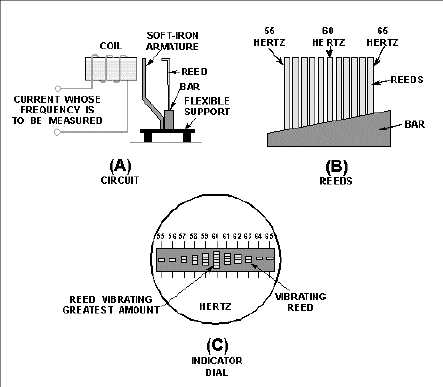1-51
to monitor the frequency of ac. A simplified diagram of one type of vibrating-reed frequency meter is
shown in figure 1-47.
Figure 1-47.—Simplified disc of a vibrating-reed frequency meter. INDICATOR DIAL
The current whose frequency is to be measured flows through the coil and exerts maximum
attraction on the soft-iron armature TWICE during each cycle (fig. 1-47(A)). The armature is attached to
the bar, which is mounted on a flexible support. Reeds having natural vibration frequencies of 110, 112,
114, and so forth, up to 130 hertz are mounted on the bar (fig. 1-47(B)). The reed having a frequency of
110 hertz is marked 55 hertz; the one having a frequency of 112 hertz is marked 56 hertz; the one having
a frequency of 120 hertz is marked 60 hertz; and so forth.
When the coil is energized with a current having a frequency between 55 and 65 hertz, all the reeds
are vibrated slightly; but, the reed having a natural frequency closest to that of the energizing current
(whose frequency is to be measured) vibrates more.
The frequency is read from the scale value opposite the reed having the greatest vibration.
In some instruments the reeds are the same lengths, but are weighted by different amounts at the top
so that they will have different natural rates of vibration.
An end view of the reeds is shown in the indicator dial of figure 1-47(C). If the current has a
frequency of 60 hertz per second, the reed marked "60" hertz will vibrate the amount, as shown.

